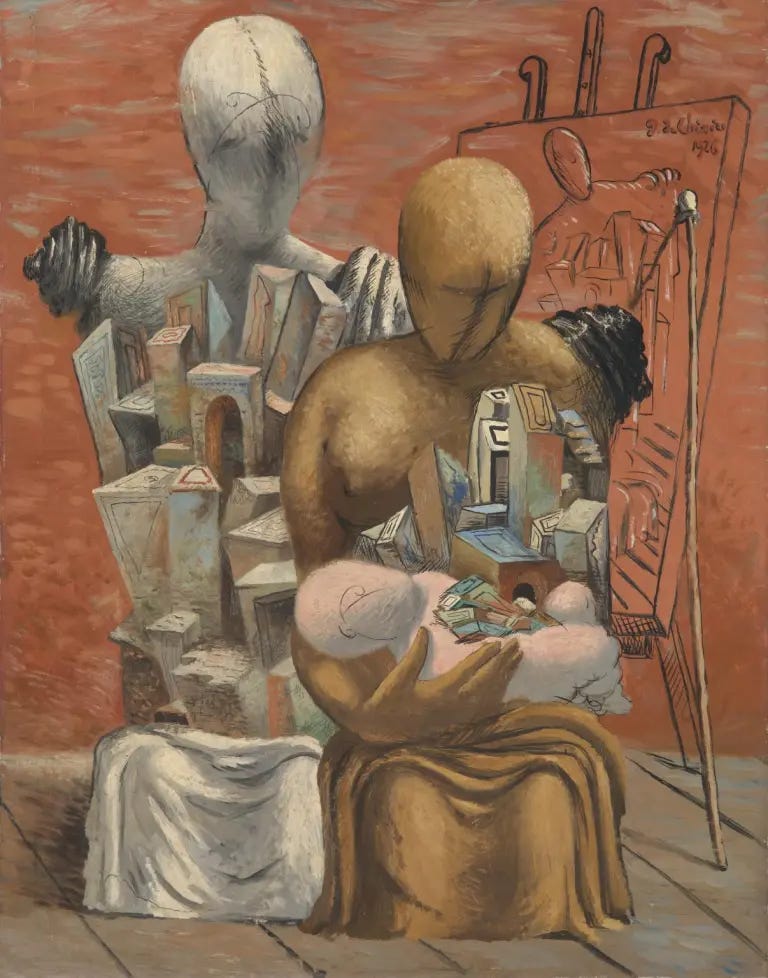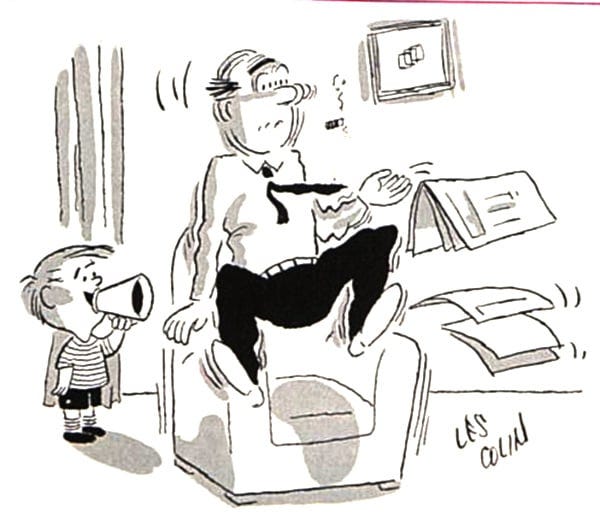#17: "Dad" brain
The biological transformation that enables men to go far beyond the socially constructed mold of fatherhood; better fathers lead to happier couples, stronger children, and ultimately, a better society
“You are the bows from which your children as living arrows are sent forth.
The archer sees the mark upon the path of the infinite, and He bends you with His might that His arrows may go swift and far.
Let your bending in the archer’s hand be for gladness;
For even as He loves the arrow that flies, so He loves also the bow that is stable.”
— Kahlil Gibran
I. Introduction
One of my main reflections from my first year as a father was just how differently I felt, beyond the overwhelming emotions and lifestyle changes. Even labeling it as a renewed outlook on life felt insufficient, both because of the type and intensity of the difference. While articulating that journey warrants its own piece, I became interested in being able to tangibly explain the underpinning and possibility of such an experience. This piece is the latter, meant to explore the science behind fatherhood — the dad brain — and make a case for adding this layer to our collective decision-making around newborn care.
The common perception around parenting is that “motherhood is a biological necessity, but fatherhood is a social invention” (quote attributed to anthropologist Margaret Mead).
Despite the increasing conversation around more equal parenting and contributing to (invisible) domestic labor, the critical component missing is the recognition that fathers also go through a substantial neuroendocrine transformation in the postpartum phase, pushing fatherhood from a learnt and logical act to an instinctive and reflexive one.
Fatherhood has an underlying biological reality that gets suppressed by the confines that social norms and the political economy place on parental roles. It also debunks the myth, often used by men to justify subpar contributions towards parenting, that men are simply not capable of doing more — weaponized incompetence — and that fathers have no major, non-logistical role in early childhood.
Instead, fathers have a biological pathway to add multiple arrows to their quiver — even beyond the progressive expectations of today — in order to be self-sufficient parents that don’t rely on translation of their child via the mother. This isn’t to draw parallels with motherhood, of course; rather, it is about developing a distinct, additive, and well-rounded parental capability.
Fathers may undergo a profound neuroendocrine transformation that results in the rewiring of their brains and new hormonal patterns. This lead to changes in how they think, feel, socially engage, parent, and perceive the world. This has profound impacts on the child’s development (better care = better development) and inter-parent dynamics (more sharing of the emotional and care-giving burden)
Potentially is a key word here because unlike with mothers, where pregnancy, birth, and post-birth care biologically drive the neuroendocrine transformation, fathers have to take active steps to prime themselves for this to occur. Therefore, it is not a given, and just like with any other process, exists across a spectrum of intensity.
The golden window for this priming is the first weeks before post-birth. Hormonal changes that enable this transformation are at their peak at that time, so diving into activities that fathers want to convert into habits kicks off a virtuous cycle of reinforcement.
Learning to function on less sleep, to read the baby’s cues and respond with optimal emotional regulation, to develop tolerance for (long bouts of) crying, to handle all caregiving tasks independently, and to tune your instincts to the child — these foundations are forged in the trenches of early parenthood; the sleepless nights, the mistakes, the flashes of frustration, the unrequited and deeply intentional affection, and the flickers of joy are all critical. The suffering is the rite of passage.
The baby is also vulnerable and looking for connection so every moment, to the extent possible, counts.
Let’s now expand on the various roles point. 4 roles can be classified as newborn/toddler “parenting”:
Provider: Ensures that material needs are met, typically through income-generation.
Playmate: Engages in fun activities, typically for time-bound periods (till the good mood lasts).
Caregiver: Performs actions to support the baby’s needs and wants (e.g., feeding, changing, developmental activities)
Emotional regulator: Serves as an emotional anchor and source of comfort during times of distress (baby distress, which is basically random moments throughout the day)
I’d argue that this list is ordered by complexity, and hence difficulty, of the task. The purpose of the neuroendocrine transformation is to biologically prepare the father for the tougher roles — i.e., caregiver and emotional regulator.

II. Neuroplasticity
“Neuroplasticity refers to the reorganization of the brain (physiological and anatomic changes) as a result of our interactions with the environment, allowing for the adaptation to new circumstances and demands” — Demarin et al., 2014
Before getting into the dad brain, it is useful to introduce the concept of neuroplasticity.
Learning is the process by which our brain develops networks of neurons connected through synapses. When we engage in a new activity, the corresponding neural pathways strengthen through repetition and focused attention.
Although 80% of our brain develops in the first 3 years of our life, there is an ongoing process of branching and pruning in our neural circuitry. This means that our brains are constantly learning new (branching) and cutting unused, or no longer required, things (pruning).
Neuroplasticity is the brain’s ability to rewire itself. It reaches its highest levels during three key stages of life: early childhood (ages 0–3), puberty, and new parenthood — rare windows when we are especially primed for growth.
This rewiring is dependent on external stimuli and repeated patterns rather than pre-determined processes, which is why the concept of priming, particularly for fathers, since no biological process related to birth exists, becomes essential.
It also means that these changes are, or can be, permanent. The brain literally looks different as a result of this transformation.
This realization is powerful because until recently, I hadn’t understood how biologically pivotal parenthood is. Whether men embrace it or not, their bodies are evolutionary designed for this moment to be a profound force for change — and it’s up to us to honor it.
III. Unlocking fatherhood
“Despite not experiencing in-person the hormonal changes of pregnancy, research has shown that fathers engage similar neural circuitry when processing infant-related stimuli compared to mothers” — Swain et al., 2007
We can understand this transformation by looking at the endocrine and neurological changes separately, and then how they form a reflexive loop.
Endocrine changes
Oxytocin (increase): Often dubbed the “cuddle hormone” or “love hormone,” oxytocin rises in new fathers during interactions with their baby. Both moms and dads experience oxytocin boosts after birth, though the triggers may differ. This makes fathers more nurturing and open to warm, care-giving behaviors like holding, caressing, skin-to-skin contact, etc. Higher oxytocin essentially rewards a dad for spending time with his baby, reinforcing his desire to engage.
Prolactin (increase): While this is known as the milk-producing hormone in nursing mothers, it’s also found to increase in fathers. Dads with more prolactin have shown stronger positive responses to infant cries, meaning this hormone might prime them to be extra sympathetic rather than annoyed when the baby wails in the middle of the night. Interestingly, experienced fathers have an even bigger prolactin spike when they hear their baby cry or hold their infant, compared to first-time dads, which suggests that as you learn how to care for your baby, your body “ramps up” its nurturing hormones to meet the demand.
Cortisol (increase): Cortisol, the stress hormone, isn’t all bad – it also helps with alertness. In both moms and dads, cortisol levels peak around the time of birth. New fathers often have higher baseline cortisol and a bigger cortisol release when holding their newborn. Rather than indicating harmful stress, this elevated cortisol may function like nature’s coffee: keeping the father vigilant and focused on the baby. Research shows higher cortisol in fathers is linked with greater paternal responsiveness – it might boost that urgent “I need to check on the baby” feeling when you hear a little cough or cry. Essentially, a moderate cortisol surge helps new fathers rise to the occasion and stay attentive during those challenging early weeks (even on little sleep).
Estrogen (yes, men have it too – and it rises): Believe it or not, new dads also see a bump in estrogen levels. Men produce a small amount of the estrogen hormone, and during early fatherhood it increases (likely through conversion of hormones or contact with pheromones from mom and baby). This rise in what’s typically thought of as a “female” hormone might further sensitize a man’s brain to baby cues. Estrogen in dads is believed to up-regulate certain receptors in the brain, essentially making neural circuits more responsive to infant needs.
Vasopressin (increase): Vasopressin is a hormone linked to territoriality and bonding. While its role in human fathers is still being studied, animal research is intriguing: in monogamous rodents like prairie voles, vasopressin can trigger paternal behaviors even in males that never had offspring. Human dads show more vasopressin activity when engaging in stimulating play with their kids, suggesting it may encourage protective, devoted parenting. Think of vasopressin as contributing to that fierce sense of “I will take care of and defend this little one” that many fathers feel. It likely works alongside testosterone (lowering it) to shift a man’s priorities from competing with other adults to safeguarding his family.
Testosterone (decrease): It’s almost funny to talk about testosterone decrease as a positive given the new cultural obsession with testosterone boosting therapies. But yes, testosterone does fall as part of this transformation, enabling fathers to turn up the empathy dial and turn down the hyper-competitive, aggressive dial. There is also a strong impact at the micro, momentary level as well. When it’s 3am and the baby won’t stop crying, lower testosterone is important to limit the possibility of a potentially harmful outburst driven by frustration and tiredness. Also, it’s not men with lower testosterone level prior to fatherhood that go down this path; in fact, higher testosterone levels have been found in men who go on to become better partners and fathers, with the sharp drop coming post-fatherhood.
Neurological changes
The hormonal changes trigger and enable behaviors that, when done repeatedly, create neutral networks that change the brain structure of fathers. MRI studies of first-time dads have revealed distinct changes in brain structure and activity after the baby arrives. Some brain regions actually shrink a bit, while others grow or light up more readily — this is part of the pruning and expanding process which is heightened in phases of neuroplasticity. These shifts may sound odd, but they reflect the brain’s way of streamlining and strengthening the skills needed to be a good parent.
Prefrontal Cortex (decrease): The prefrontal cortex (PFC), right behind your forehead, handles logic, planning, and self-control. Interestingly, studies have found that certain portions of the PFC become a bit smaller in volume in new fathers. In particular, areas like the orbitofrontal cortex (involved in decision-making and evaluating rewards) showed small reductions in gray matter after men had their first child. This pruning might indicate that dads start relying less on purely analytical, cost-benefit thinking when responding to their baby and rely more on cognitive empathy — again, critical when you’re frustrated and tired. Other parts of the PFC ramp up in fathers: researchers saw growth in lateral prefrontal areas important for motivation and goal-directed behavior. The net effect is a father who’s less bogged down by plans and more inclined to just do what needs to be done for his baby, with a kind of focused efficiency.
Amygdala (increase): Deep in the brain, the amygdala is an almond-shaped region crucial for processing emotions and detecting important signals (like a baby’s cry). For new dads, the amygdala becomes more active and even grows in volume. This is a sign that the father’s “alert system” is on high — he becomes extra vigilant to his infant’s needs. A heightened amygdala response makes dad more sensitive to baby’s distress sounds and facial expressions, triggering an almost reflexive urge to help.
Hypothalamus (increase): The hypothalamus is a small but powerful brain region that controls hunger, sleep cycles, and crucially, hormone release (it’s the mastermind directing oxytocin, cortisol, etc.). MRI research shows the hypothalamus actually enlarges in volume in first-time fathers. It also becomes more responsive to infant cues. Essentially, fatherhood puts the hypothalamus on high alert, ready to signal the body to release parenting hormones at the right moments. This change dovetails with the hormonal shifts discussed earlier – a primed hypothalamus will, for example, spur more oxytocin release when dad holds his baby, strengthening bonding. It might also trigger that surge of adrenaline or alertness when the baby cries (helping dad wake up and attend to a 2 AM feeding). By beefing up the hypothalamus, the brain is hard-wiring the motivational drive to care for the child.
Reward Circuit (striatum and dopamine pathways): Too many times parenting is framed as rewarding for the mother but not the father; however, nature ingeniously makes it rewarding for fathers as well. In new fathers, parts of the brain’s reward system — including the striatum, which is rich in dopamine — show increases in gray matter. In simple terms, this means that interacting with your baby becomes especially satisfying to the brain. When you see your newborn smile or hear them coo, the reward circuit fires off feel-good signals. By enlarging or strengthening these reward regions, the “dad brain” ensures that you enjoy bonding with your baby and are motivated to keep doing it. You might find that rocking your baby or making silly faces to get a giggle gives you a genuine rush of joy — that’s your enhanced reward system at work, making you an affectionate, engaged father.
Insula (and other emotional empathy regions): The insula is a region that helps translate body signals into emotions and empathy (letting you feel others’ pain or discomfort internally). During fatherhood, there is a reduction in grey matter but higher activation in this region, potentially mean that the brain is cutting out noise and honing in on truly relevant emotional signals from the baby. The result might be that dad becomes highly attuned to his infant’s emotional states – you might get a “gut feeling” when something’s off with your child.
IV. Conclusion
As Sarah Blaffer Hrdy notes in her book Father Time, the “same molecules and neural circuits” that drive maternal instincts can be activated in men.
So where does this leave us? This piece is meant to be nothing more than an introduction to, and framework for, how fatherhood entails a significant biological transformation in men. The hormonal and neurological changes described above are not meant to comprehensive; instead, they are indicative of how this isn’t merely a social role that men stumble their through and has deep, ancient roots in their evolution.
It’s also not about mimicking or trying to take over the maternal role, it’s about going deep into the unique relationship that fathers bring — this is also why the positive triggers for fathers are different to those for mothers. The rewiring and fine-tuning of the male brain adds to it’s existing skill set and enhances capabilities, rather than nonsense of becoming weaker (read = softer) and less rational that today’s culture wars will have you believe.
At the same time, capitalism perpetuates a cycle of servitude to employment and reduces satisfaction to corporate success to the extent that people, especially men, choose to — and in many cases are forced to — not immerse themselves into this experience.
Being a nurturing father is hugely beneficial for children (evidence for better cognitive and emotional development), inter-parent relationships (more load sharing & empathy), men themselves (reward activation), and society (more pro-social people with cognitive empathy — something we desperately need today).
These changes are also probabilistic, not deterministic, meaning that the outcome depends significantly on the underlying personality and experiences of each person, as well as (most importantly), the conditions that are created to activate this transformation.
Ultimately, there are a few things I’d want readers to takeaway from this:
The more time, intention, labor and vulnerability men put into it, the more they get from it.
The window of maximum flexibility (neuroplasticity) is the weeks and months after birth.
These changes are probabilistic, not deterministic, meaning that the journey and outcomes looks differently for everyone.
The physical tiredness from sleepless nights, the emotional exhaustion from hyper-fixating on how this little thing is supposed to survive, the mental fatigue from suddenly having to be hyper-aware continuously, as well as all the cuddles, silliness, and flickers of joy are a rite of passage to become instinctively and deeply attuned to your baby’s existence.
I’d even say that it is in these moments that the foundations of a cosmic and telepathic relationship are built.
Reading list:
Greer Kirshenbaum, The Nurture Revolution (2023)
Sarah Blaffer Hrdy, Father Time: A Natural History of Men and Babies (2024)
Plasticity of the Paternal Brain: Effects of Fatherhood on Neural Structure and Function
Neurobiological Correlates of Fatherhood During the Postpartum Period: A Scoping Review



